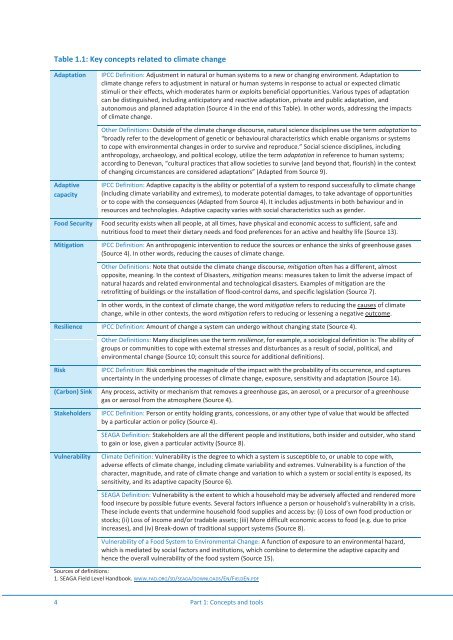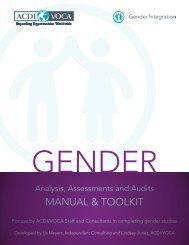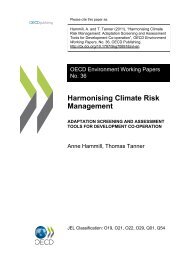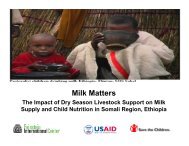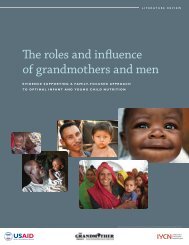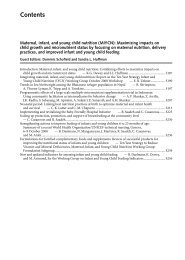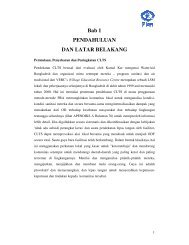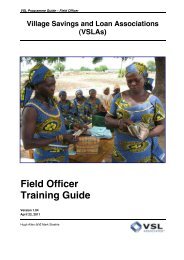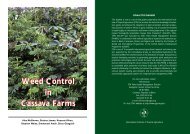Gender and climate change research in - FAO
Gender and climate change research in - FAO
Gender and climate change research in - FAO
Create successful ePaper yourself
Turn your PDF publications into a flip-book with our unique Google optimized e-Paper software.
Table 1.1: Key concepts related to <strong>climate</strong> <strong>change</strong><br />
Adaptation<br />
Adaptive<br />
capacity<br />
Food Security<br />
Mitigation<br />
IPCC Def<strong>in</strong>ition: Adjustment <strong>in</strong> natural or human systems to a new or chang<strong>in</strong>g environment. Adaptation to<br />
<strong>climate</strong> <strong>change</strong> refers to adjustment <strong>in</strong> natural or human systems <strong>in</strong> response to actual or expected climatic<br />
stimuli or their effects, which moderates harm or exploits beneficial opportunities. Various types of adaptation<br />
can be dist<strong>in</strong>guished, <strong>in</strong>clud<strong>in</strong>g anticipatory <strong>and</strong> reactive adaptation, private <strong>and</strong> public adaptation, <strong>and</strong><br />
autonomous <strong>and</strong> planned adaptation (Source 4 <strong>in</strong> the end of this Table). In other words, address<strong>in</strong>g the impacts<br />
of <strong>climate</strong> <strong>change</strong>.<br />
Other Def<strong>in</strong>itions: Outside of the <strong>climate</strong> <strong>change</strong> discourse, natural science discipl<strong>in</strong>es use the term adaptation to<br />
“broadly refer to the development of genetic or behavioural characteristics which enable organisms or systems<br />
to cope with environmental <strong>change</strong>s <strong>in</strong> order to survive <strong>and</strong> reproduce.” Social science discipl<strong>in</strong>es, <strong>in</strong>clud<strong>in</strong>g<br />
anthropology, archaeology, <strong>and</strong> political ecology, utilize the term adaptation <strong>in</strong> reference to human systems;<br />
accord<strong>in</strong>g to Denevan, “cultural practices that allow societies to survive (<strong>and</strong> beyond that, flourish) <strong>in</strong> the context<br />
of chang<strong>in</strong>g circumstances are considered adaptations” (Adapted from Source 9).<br />
IPCC Def<strong>in</strong>ition: Adaptive capacity is the ability or potential of a system to respond successfully to <strong>climate</strong> <strong>change</strong><br />
(<strong>in</strong>clud<strong>in</strong>g <strong>climate</strong> variability <strong>and</strong> extremes), to moderate potential damages, to take advantage of opportunities<br />
or to cope with the consequences (Adapted from Source 4). It <strong>in</strong>cludes adjustments <strong>in</strong> both behaviour <strong>and</strong> <strong>in</strong><br />
resources <strong>and</strong> technologies. Adaptive capacity varies with social characteristics such as gender.<br />
Food security exists when all people, at all times, have physical <strong>and</strong> economic access to sufficient, safe <strong>and</strong><br />
nutritious food to meet their dietary needs <strong>and</strong> food preferences for an active <strong>and</strong> healthy life (Source 13).<br />
IPCC Def<strong>in</strong>ition: An anthropogenic <strong>in</strong>tervention to reduce the sources or enhance the s<strong>in</strong>ks of greenhouse gases<br />
(Source 4). In other words, reduc<strong>in</strong>g the causes of <strong>climate</strong> <strong>change</strong>.<br />
Other Def<strong>in</strong>itions: Note that outside the <strong>climate</strong> <strong>change</strong> discourse, mitigation often has a different, almost<br />
opposite, mean<strong>in</strong>g. In the context of Disasters, mitigation means: measures taken to limit the adverse impact of<br />
natural hazards <strong>and</strong> related environmental <strong>and</strong> technological disasters. Examples of mitigation are the<br />
retrofitt<strong>in</strong>g of build<strong>in</strong>gs or the <strong>in</strong>stallation of flood-control dams, <strong>and</strong> specific legislation (Source 7).<br />
In other words, <strong>in</strong> the context of <strong>climate</strong> <strong>change</strong>, the word mitigation refers to reduc<strong>in</strong>g the causes of <strong>climate</strong><br />
<strong>change</strong>, while <strong>in</strong> other contexts, the word mitigation refers to reduc<strong>in</strong>g or lessen<strong>in</strong>g a negative outcome.<br />
Resilience IPCC Def<strong>in</strong>ition: Amount of <strong>change</strong> a system can undergo without chang<strong>in</strong>g state (Source 4).<br />
Risk<br />
(Carbon) S<strong>in</strong>k<br />
Stakeholders<br />
Vulnerability<br />
Other Def<strong>in</strong>itions: Many discipl<strong>in</strong>es use the term resilience, for example, a sociological def<strong>in</strong>ition is: The ability of<br />
groups or communities to cope with external stresses <strong>and</strong> disturbances as a result of social, political, <strong>and</strong><br />
environmental <strong>change</strong> (Source 10; consult this source for additional def<strong>in</strong>itions).<br />
IPCC Def<strong>in</strong>ition: Risk comb<strong>in</strong>es the magnitude of the impact with the probability of its occurrence, <strong>and</strong> captures<br />
uncerta<strong>in</strong>ty <strong>in</strong> the underly<strong>in</strong>g processes of <strong>climate</strong> <strong>change</strong>, exposure, sensitivity <strong>and</strong> adaptation (Source 14).<br />
Any process, activity or mechanism that removes a greenhouse gas, an aerosol, or a precursor of a greenhouse<br />
gas or aerosol from the atmosphere (Source 4).<br />
IPCC Def<strong>in</strong>ition: Person or entity hold<strong>in</strong>g grants, concessions, or any other type of value that would be affected<br />
by a particular action or policy (Source 4).<br />
SEAGA Def<strong>in</strong>ition: Stakeholders are all the different people <strong>and</strong> <strong>in</strong>stitutions, both <strong>in</strong>sider <strong>and</strong> outsider, who st<strong>and</strong><br />
to ga<strong>in</strong> or lose, given a particular activity (Source 8).<br />
Climate Def<strong>in</strong>ition: Vulnerability is the degree to which a system is susceptible to, or unable to cope with,<br />
adverse effects of <strong>climate</strong> <strong>change</strong>, <strong>in</strong>clud<strong>in</strong>g <strong>climate</strong> variability <strong>and</strong> extremes. Vulnerability is a function of the<br />
character, magnitude, <strong>and</strong> rate of <strong>climate</strong> <strong>change</strong> <strong>and</strong> variation to which a system or social entity is exposed, its<br />
sensitivity, <strong>and</strong> its adaptive capacity (Source 6).<br />
SEAGA Def<strong>in</strong>ition: Vulnerability is the extent to which a household may be adversely affected <strong>and</strong> rendered more<br />
food <strong>in</strong>secure by possible future events. Several factors <strong>in</strong>fluence a person or household’s vulnerability <strong>in</strong> a crisis.<br />
These <strong>in</strong>clude events that underm<strong>in</strong>e household food supplies <strong>and</strong> access by: (i) Loss of own food production or<br />
stocks; (ii) Loss of <strong>in</strong>come <strong>and</strong>/or tradable assets; (iii) More difficult economic access to food (e.g. due to price<br />
<strong>in</strong>creases), <strong>and</strong> (iv) Break-down of traditional support systems (Source 8).<br />
Vulnerability of a Food System to Environmental Change: A function of exposure to an environmental hazard,<br />
which is mediated by social factors <strong>and</strong> <strong>in</strong>stitutions, which comb<strong>in</strong>e to determ<strong>in</strong>e the adaptive capacity <strong>and</strong><br />
hence the overall vulnerability of the food system (Source 15).<br />
Sources of def<strong>in</strong>itions:<br />
1. SEAGA Field Level H<strong>and</strong>book. WWW.<strong>FAO</strong>.ORG/SD/SEAGA/DOWNLOADS/EN/FIELDEN.PDF<br />
4 Part 1: Concepts <strong>and</strong> tools


